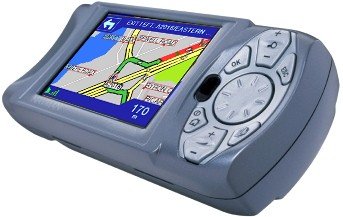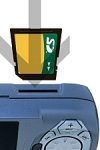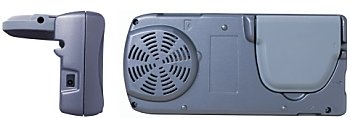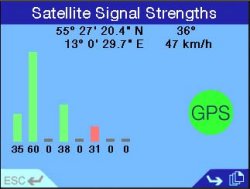|
Review by
Dave Burrows
Introduction
The Navman iCN630 is a new kid
on the block in terms of a complete integrated Street Routing system without the
need for any type of PDA. The iCN630 uses a modified version of Navman's
newest software (SmartST Professional) and this on the iCN630 this is called SmartMap.

Navman iCN630
With the release of the Navman iCN630, Navman are
trying to compete with the likes of Garmin who have had an enormous share of the
market with the Street Pilot III because excluding PDA systems and fully
installable in-car systems, there has been no real competition for them until
now. Although both systems use the same maps
provided by NavTech, the interfaces and maps look completely different.
When you power on the iCN630 and start looking at the maps, the first thing
you'll notice if you've already seen SmartST Pro is
how very similar the system looks. In-fact any changes made by Navman for
SmartST Pro can be ported to the iCN630 and vice versa as the systems are very similar both from a program point
of view and also from a hardware/processor point of view. The routing
screens are about the only thing that is different, on the iCN630 you don't get
the nicely coloured borders around the map that you would see on an iPAQ.
iCN630 and vice versa as the systems are very similar both from a program point
of view and also from a hardware/processor point of view. The routing
screens are about the only thing that is different, on the iCN630 you don't get
the nicely coloured borders around the map that you would see on an iPAQ.
What's in the box ?
Storage Space
One of the first things I noticed that disappointed me with the
iCN630 is not only the price which is more expensive than the Street Pilot III,
but you also don't get any storage cards supplied with the Navman where as
Garmin supply you with a 128mb storage card. What does this mean ?
If you're looking to put a large amount of maps onto the iCN630
like complete UK maps, then this will not be possible with the supplied
equipment as the iCN630 only has 64mb of storage space which will probably get
you a couple of maps installed depending on the size of the segments. I
managed two myself. So in additional to purchasing the iCN630, you will
need to look at purchasing at minimum a 128mb MMC or SD Card. If you are
looking to also house the complete European maps, then I would strongly suggest
purchasing a 256mb or even a 512mb SD card, because you know you're going to
need to use it at some point! SD card prices are constantly coming down in
price and you can pick up a 128mb SD card for around £35, so I would have
thought that Navman could have chucked this in for free.
Antenna

The iCN630 comes with a built in antenna which is multi directional and
will increase the availability of the signal and comes supported with an
external MCX connector allowing you to plug in an external active antenna if you
feel you require it.

One thing I have found under testing, at no point did I have to
extend the multi-directional antenna or use an external antenna, I always had
the internal antenna folded flat and it
always used to receive an adequate amount of satellites to give me a 3D fix even when
in the worst of conditions.


Speaker
The integrated speaker on the iCN630 is very clear even though it
is facing the wrong direction. Unlike the Garmin Street Pilot III, the
speaker is available within the unit where the SPIII you had to use the supplied
car charger/speaker plug. Navman have done well including the speaker into
the unit. Voice Navigation is also very loud and can be adjustable within
the iCN630 using the keypad supplied (no jog dial). Running the iCN630
side by side with an iPAQ 3630 the speech was much louder and clearer in the
iCN630 which is something we were originally concerned about with SmartST Pro,
so it's good to see this has been addressed. The Voice Navigational
quality is also much better, where SmartST Pro sounds like someone has spoken
each word in turn and glued them together, the iCN630 has fluent voice
navigation which makes it a lot easier to listen to when driving at speed.
Screen Quality
The screen quality on the iCN630 is outstanding. The
colours are rich and the contrast strong. The screen sports a 3.8" TFT
QVGA screen for use in-car with anti-reflective coating. The screen
dimensions are 320x240 pixels with more than 230,000 colours. Not quite as
much as a Pocket PC, but 64 million colours really aren't needed for mapping and
230,000 colours should be more than enough to contend with various shades of
colours.

Something the more advanced GPS user may recognise is that many
in-car navigation systems includeing the iCN630 are always designed in a landscape mode screen layout
(eg longer screen and shorter height), this is the norm for TV's and monitor's, but most PDA based
GPS systems are the
opposite using a portrait mode system. There's no rhyme nor reason for this
really, landscape systems look more aesthetical but in theory will provide less
information on screen (height wise). I pitted the iCN630 together side by
side with an iPAQ running SmartST Pro in my tests and you did find sometimes you
lost a little bit of map data on the height of the screen on the iCN630, but in
most cases it was nearly identical. The way Navman have managed to get
around this is to reduce the overall size of the maps on screen that you would
see, which in a sense is like zooming out. Now because with most PDA GPS
Systems you are always facing/travelling up the screen, it does mean that there
is a lot of wasted real estate on screen on the left and right hand sides of the
screen. It's not entirely wasted as it's always good to see where you are
on a map and the more information you have the better, but I would have thought
it better to have a portrait system, or even better a system that can switch
easily between portrait and landscape modes. I'm sure this will come in
later products.
Suction Cup Strength
One thing that Navman customers have constantly complained about
with the Navman 3000 and Navman 3400/3420 is the strength of the suction cup.
If left in direct sunlight most people would find after a few days their suction
cup has fallen to the floor. This can and did happen sometimes whilst
travelling as driving over bumps would loosen the suction on the windscreen.
One thing I can categorically say, is the windscreen mount supplied with the
iCN630 will not have this problem! It's so strong, you can even hang onto
the iCN630 whilst it's suctioned to the windscreen and pull it in all directions
and adjust the direction it's facing. This newly designed suction cup is
much better than previously supplied in the Navman 3000 and 3400/3420 packages
so having your prized possession drop from the windscreen is a thing of the past
for Navman users!
Time To First Fix and Satellite Information
With the extensive testing I have carried out in this review, I have witnessed
no extended TTFF's, in-fact most are sub one minute. The iCN630 didn't
ever lose a 3D fix at anytime. With Pocket PC systems I religiously used to check that I had a 4+ sat fix
before planning a route, but found myself not having to do this, which makes the
iCN630 very desirable, in effect just plug in, switch on and go!
The first GPS Status screen is similar to what SmartST Pro owners
would be used to and this shows your co-ordinates, speed and direction, date and time and
also a visual large circle indication if you have a fix (green) or no fix (red) and how many
green/yellow/red bars you have which suggest the amount of sat fix you have.
The second satellite screen you'll see this same information but with signal
strength for each satellite which most people will be used to seeing in GPS
products.


|